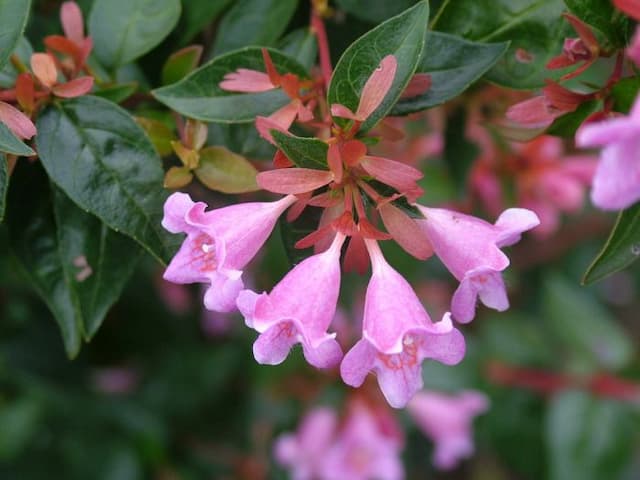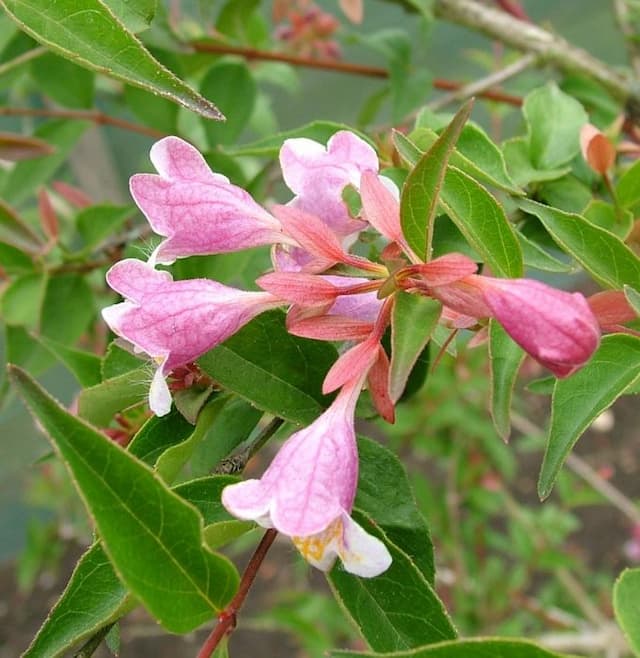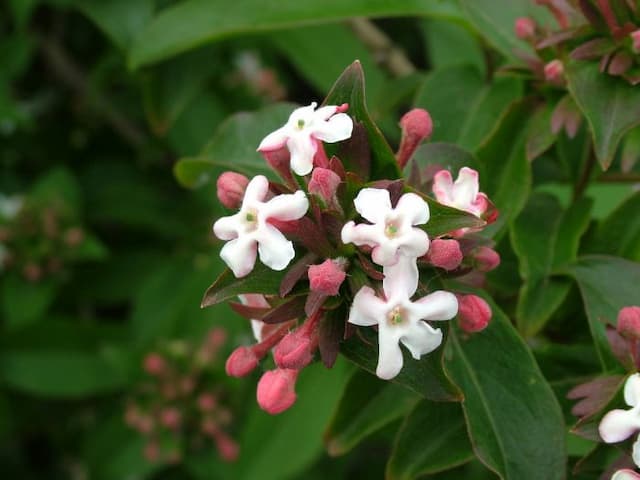Pyrenean Valerian Valeriana pyrenaica

ABOUT
Valeriana pyrenaica, commonly known as Pyrenean valerian, is a perennial herb that is notable for its lush foliage and attractive flowering heads. The plant bears a rosette of basal leaves that are usually heart-shaped or deeply lobed and often feature a toothed margin. The leaves are typically a rich green color and have a smooth texture. As the flowering season approaches, Pyrenean valerian produces tall flowering stems that are topped with clusters of small, fragrant flowers. These flowers are usually a pale pink or sometimes white, and they have a delicate, sweet aroma that is often described as calming. The inflorescence is a cyme, meaning the flowers are arranged in a flat-topped or rounded cluster, and they are a favorite among bees and butterflies. The root system of Pyrenean valerian is substantial, with thick roots that are sometimes used for their reputed medicinal properties. Overall, the plant has a lush and graceful appearance, making it a charming addition to gardens or naturalized areas where it creates an inviting habitat for pollinators.
About this plant
 Names
NamesFamily
Valerianaceae
Synonyms
Pyrenean Valerian, Great Wild Valerian
Common names
Valeriana montana, Valeriana tuberosa, Valeriana tripteris.
 Toxicity
ToxicityTo humans
Valerian (Valeriana pyrenaica) is not commonly known for its toxicity to humans. It is often used in herbal medicine for its sedative properties. However, like any plant, consuming it in excessive amounts could potentially lead to adverse effects. These effects may include headache, dizziness, stomachache, and in severe cases, possibly a sedative effect that could impair normal functioning. It is always best to consult with a healthcare professional before using valerian or any other herbal products, particularly if you are pregnant, nursing, or taking other medications.
To pets
Valerian (Valeriana pyrenaica) is generally considered to be of low toxicity to pets. It is often used in pet supplements for its calming effects. While it is not typically harmful, ingestion in large quantities could potentially lead to mild stomach upset or show sedative effects in pets. As with humans, it's always prudent to consult a veterinarian before introducing any new herbs or supplements into a pet's regimen, particularly if the pet has existing health conditions or is on medication.
 Characteristics
CharacteristicsLife cycle
Perennials
Foliage type
Deciduous
Color of leaves
Green
Flower color
Pink
Height
1-3 feet (0.3-0.9 meters)
Spread
1-2 feet (0.3-0.6 meters)
Plant type
Herb
Hardiness zones
5
Native area
Europe
Benefits
 General Benefits
General Benefits- Relaxation aid - Valerian is commonly used to help reduce symptoms of anxiety and promote relaxation.
- Sleep improvement - It is often used as a remedy for insomnia, helping to induce and improve the quality of sleep.
- Stress relief - Valerian can help in managing stress by calming the nervous system.
- Menstrual symptom relief - It may alleviate menstrual cramps and other symptoms associated with the menstrual cycle.
- Supports digestive health - Valerian has been used traditionally to ease digestive problems and may help in relieving stomach cramps.
- Soothing effect - The herb has properties that may soothe nervous headaches and migraines.
- Natural muscle relaxant - Valerian can be beneficial in relieving muscle tension and spasms.
- Historical cultural uses - Valerian has an extensive history of use in various cultures for its sedative effects and is often part of traditional medicinal systems.
- Gardening and ornamental use - With its attractive foliage and flowers, valerian can be used as a beautiful addition to gardens.
- Supports heart health - By potentially reducing anxiety and stress, it can indirectly contribute to heart health, although direct benefits require more research.
- Aroma therapeutic - Valerian oil is sometimes used in aromatherapy for its calming effects.
 Medical Properties
Medical Properties- Valeriana pyrenaica, commonly known as Pyrenean valerian, has sedative and calming effects and may help to promote sleep and reduce anxiety.
- The plant is also traditionally used as an antispasmodic agent, helping to alleviate cramps and digestive problems.
 Air-purifying Qualities
Air-purifying QualitiesThis plant is not specifically known for air purifying qualities.
 Other Uses
Other Uses- Valerian (Valeriana pyrenaica) is sometimes used in the production of natural dyes, particularly for wool and silk, giving a range of brown and green colors depending on the mordant used.
- Garden aesthetic: Valerian can be planted in cottage gardens or perennial borders for its attractive foliage and tall flowering stems.
- Companion planting: Valerian can attract beneficial insects to the garden, such as predatory wasps and pollinators, which can contribute to the health of surrounding plants.
- Decorative dried flowers: The dried flower stems of Valerian can be used in flower arrangements to add height and structure to the composition.
- Cat attraction: Similar to catnip, some components of Valerian can be appealing to cats, so it can be used in cat toys or sprinkled in their area to provide them with enjoyment.
- Culinary herb: In small quantities, Valerian can be used as a flavoring agent in cooking, similar to how one might use herbs like sage or thyme.
- Strewing herb: Historically, Valerian was used as a strewing herb to freshen the air and deter pests from indoor environments.
- Soil improver: Valerian can be grown as a green manure or cover crop to enrich soil with organic matter after it dies back.
- Natural insect repellent: Some gardeners use Valerian as a natural insect repellent in the garden due to its strong, musky odor that is believed to deter certain pests.
- Biodynamic agriculture: Valerian flower extracts are often used in biodynamic farming practices to make compost preparations aimed at enhancing soil quality and plant health.
Interesting Facts
 Feng Shui
Feng ShuiPyrenean Valerian is not used in Feng Shui practice.
 Zodiac Sign Compitability
Zodiac Sign CompitabilityPyrenean Valerian is not used in astrology practice.
 Plant Symbolism
Plant Symbolism- Relaxation: Valerian, including Valeriana pyrenaica, is often associated with relaxation due to its use in herbal medicine to promote calmness and reduce anxiety.
- Sleep and Insomnia Relief: The roots of valerian plants have been historically used as a remedy for insomnia, symbolizing a good night's sleep.
- Peace: Valerian's ability to soothe nerves ties it to the concept of peace, both inner and environmental.
- Protection: In some traditions, valerian is believed to ward off unwanted presences and is symbolically used for protection.
- Love and Affection: While not as common, some lore suggests valerian attracts love, likely due to its calming effects, fostering connection and closeness.
 Water
WaterWater your Valeriana officinalis, commonly known as Garden Heliotrope, by keeping the soil consistently moist but not waterlogged. It prefers steady moisture, so check the soil every few days and water when the top inch starts to feel dry. During the active growing season in spring and summer, this may mean watering once or twice a week, depending on weather conditions. Use about 1 gallon of water each time for a medium-sized plant to ensure adequate hydration. In the dormant winter months, reduce the frequency but never allow the soil to completely dry out.
 Light
LightGarden Heliotrope thrives best in partial shade to full sun. It prefers bright, indirect sunlight and should be protected from the harsh midday sun which can scorch its leaves. The ideal spot would be in an area that receives morning sunlight and is shaded in the hotter part of the afternoon or a location with dappled sunlight throughout the day.
 Temperature
TemperatureGarden Heliotrope favors a temperate climate and does well in temperatures between 50°F to 85°F. It can survive minimal frost but prolonged exposure to temperatures below 32°F can be damaging. The ideal temperature range for optimal growth is between 60°F and 75°F. Protect the plant from extreme temperatures by providing mulch or cover during cold snaps.
 Pruning
PruningPrune Garden Heliotrope to maintain its shape and encourage bushier growth. The best time to prune is in the late winter or early spring before new growth begins. Cutting back up to a third of the plant can help promote vigorous growth and prevent the center from becoming too woody. Remove any dead or diseased stems as needed throughout the growing season to keep the plant healthy.
 Cleaning
CleaningAs needed
 Soil
SoilPyrenean Valerian prefers well-drained, humus-rich soil with a pH of 5.5 to 7. For best results, mix loamy garden soil with compost and peat moss to enhance fertility and drainage.
 Repotting
RepottingPyrenean Valerian usually does not need frequent repotting; it can be done every 2-3 years or when the plant appears to be root-bound.
 Humidity & Misting
Humidity & MistingPyrenean Valerian thrives best at moderate humidity levels, neither too dry nor too humid; a range of 40-60% is ideal.
 Suitable locations
Suitable locationsIndoor
Provide bright, indirect light and keep soil moist for Pyrenean Valerian.
Outdoor
Plant in partial shade, provide mulch and ensure soil drainage for Pyrenean Valerian.
Hardiness zone
5-9 USDA
 Life cycle
Life cycleValeriana pyrenaica, commonly known as Pyrenean valerian, begins its life cycle as a seed that requires a period of cold stratification to break dormancy. Once germinated, the seedling grows into a rosette of leaves, developing a deep taproot. In its vegetative stage, the plant produces foliage and accumulates resources. Following this period, which can last for several years, Pyrenean valerian enters its reproductive phase, sending up tall flowering stems that bear clusters of sweetly scented pink or white flowers. After pollination, often by insects, the plant sets seed which, when mature, is dispersed by wind or animal vectors. The perennial nature of Pyrenean valerian allows it to survive through winter, with above-ground growth dying back and reemerging from its rootstock with the arrival of spring.
 Propogation
PropogationPropogation time
Spring to early summer
Valerian (Valeriana pyrenaica) is often propagated through seed, but the most popular method is by division. This typically takes place in the early spring or fall. To propagate by division, gardeners dig up the mature plant, carefully separating the root ball into smaller sections, ensuring that each new section has a part of the root system and several shoots. These sections are then replanted at the same depth as they were originally growing, spaced about a foot (30 centimeters) apart to allow room for the plants to spread. Watering the divisions immediately after planting helps to establish them in their new location. It is important to maintain consistent moisture without overwatering, as valerian prefers well-drained soil. With time and proper care, these divisions will grow into robust plants, producing their characteristic fragrant blossoms.








![Himalayan honeysuckle [Golden Lanterns]](/_next/image?url=https%3A%2F%2Fplants-admin.emdemapps.com%2Fimages%2Fplants%2F%2Fimages%2F604b55302cc87.png&w=640&q=75)
